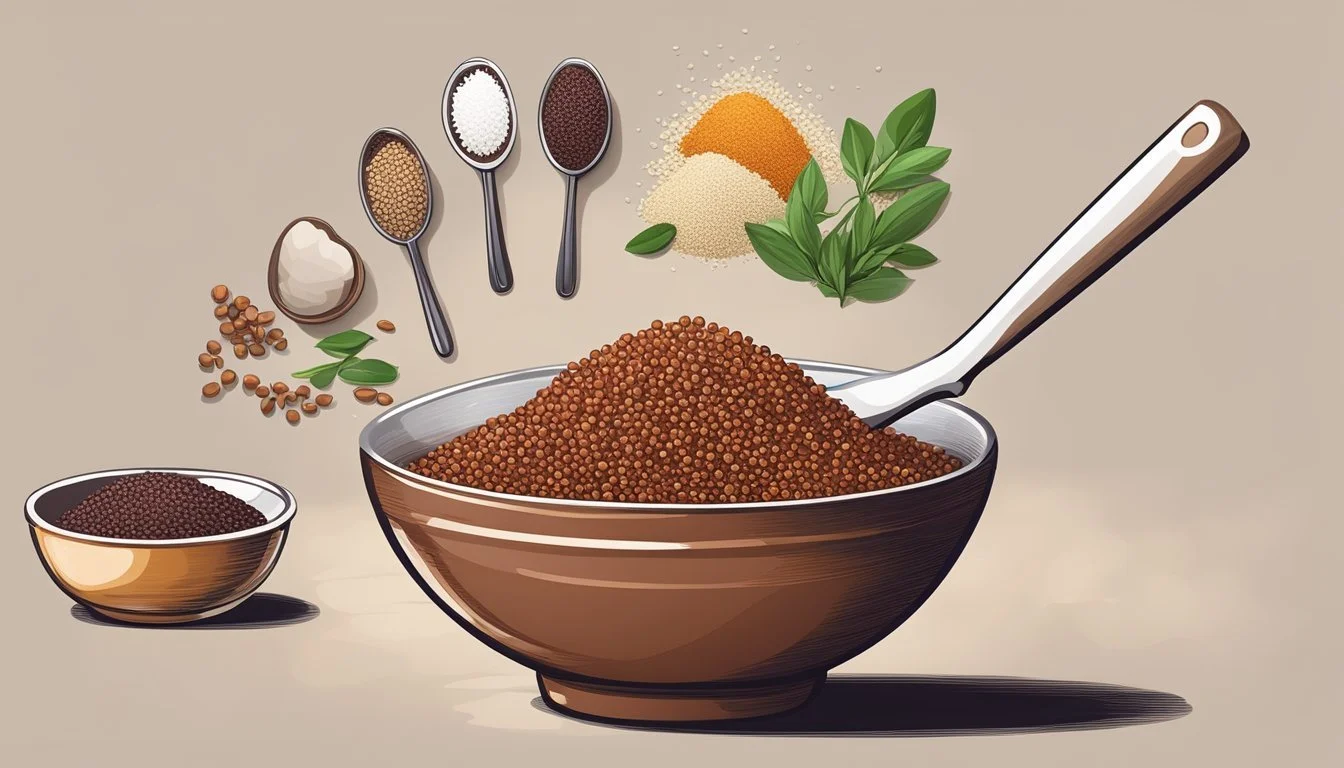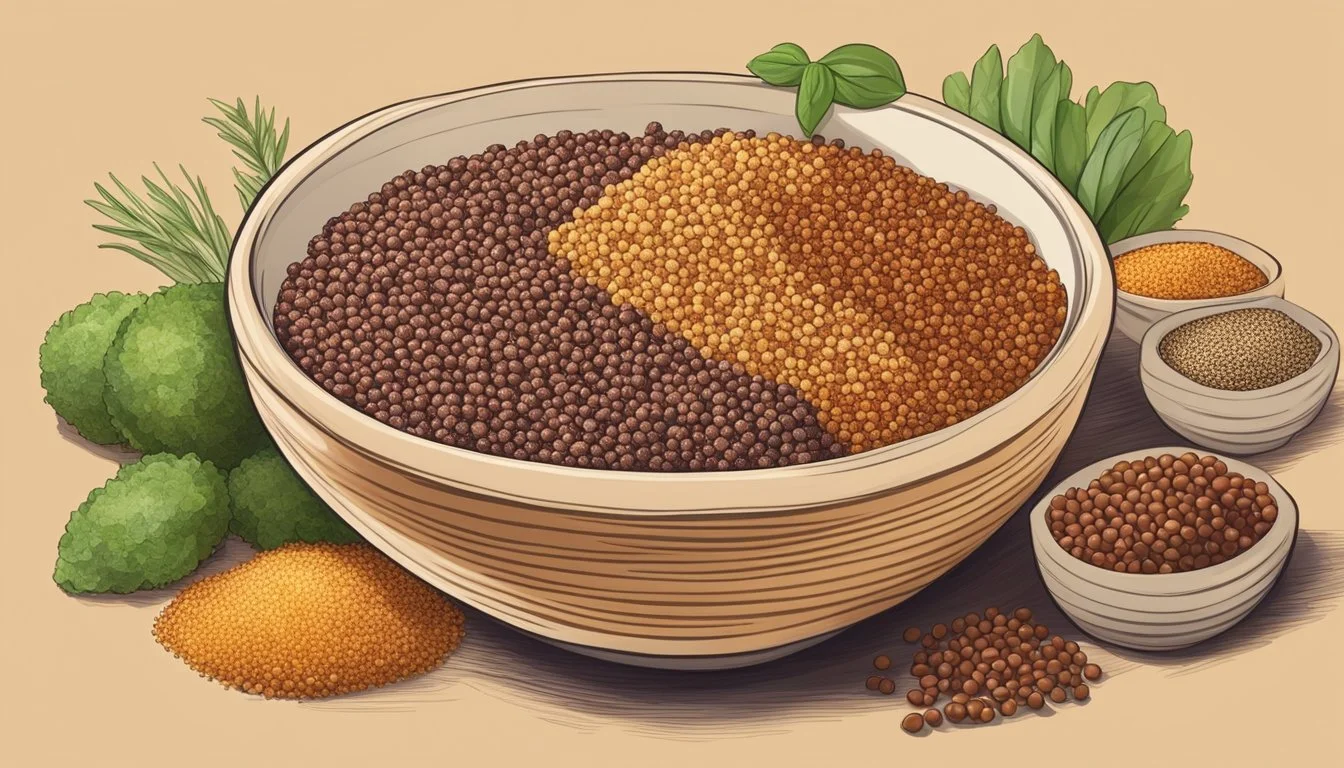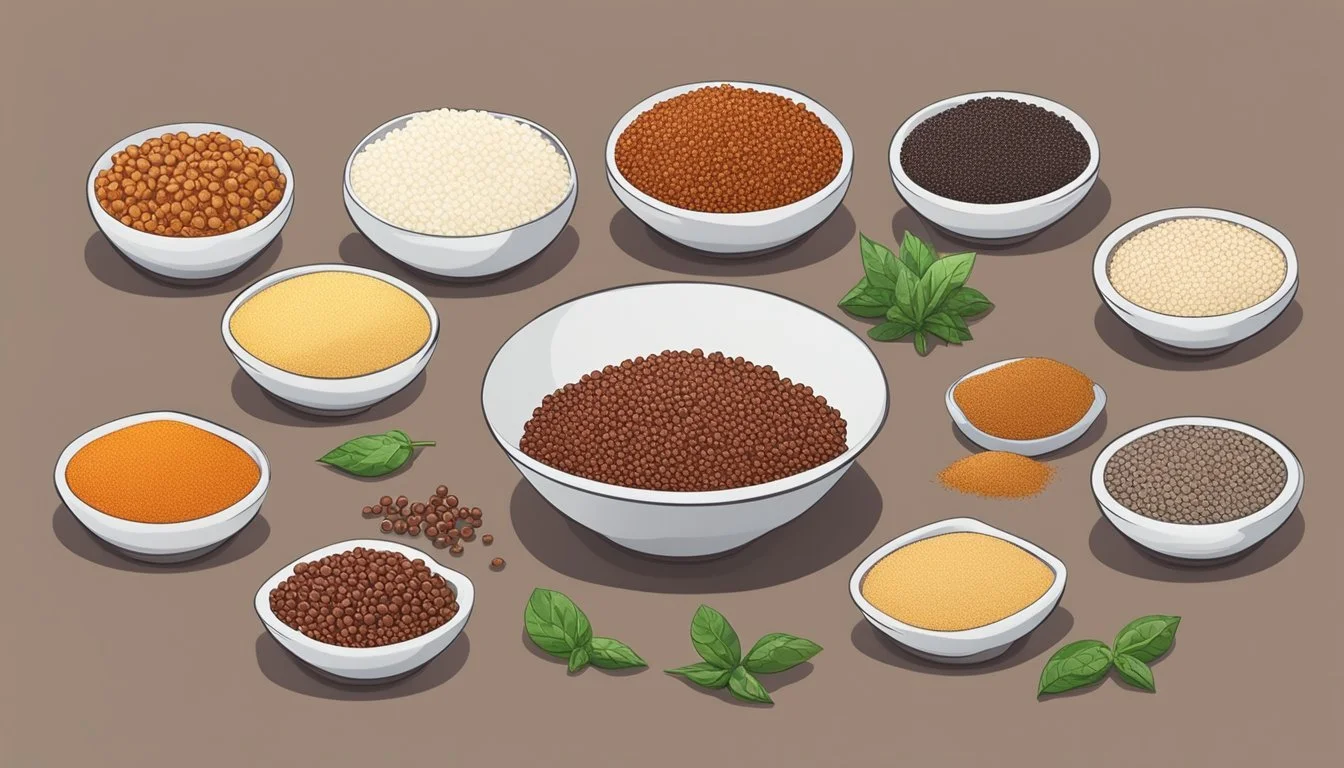Red Quinoa Substitutes
Best Alternatives for Balanced Nutrition
For those seeking alternatives to red quinoa, numerous options abound that cater to various dietary restrictions while still offering substantial health benefits. Brown rice is a fantastic substitute for red quinoa, providing a similar texture and nutritional profile with higher fiber and protein content. It pairs wonderfully with savory proteins, making it a versatile addition to any meal.
Wild rice is another excellent option, celebrated for its complete protein content and distinct flavor. It complements soups, salads, and stuffed vegetables, enhancing both taste and nutrition. For those interested in legumes, chickpeas and red beans offer cost-effective, nutrient-rich alternatives, with options available in both dry and canned forms.
Cauliflower rice and broccoli are great low-carb substitutes, perfect for those watching their carbohydrate intake. These vegetables can be used in a variety of dishes to replicate the texture of red quinoa while adding their own unique flavors and nutritional benefits. Each of these substitutes ensures a healthy, balanced diet without compromising on taste or variety.
Understanding Quinoa
Quinoa is an ancient grain cultivated primarily in South America. Known for its nutritional benefits, including high protein and fiber content, it has become a staple for health-conscious individuals.
Types of Quinoa
Quinoa comes in several varieties, with white, red, and black being the most common. White quinoa is the most commonly found in grocery stores and has the mildest flavor. It cooks faster and has a lighter, fluffier texture. Red quinoa retains its shape better and adds a more vibrant color to dishes, making it ideal for salads. Black quinoa has an earthier taste and crunchier texture, taking longer to cook compared to the other types. Each type offers distinct culinary qualities and visual appeal, making them versatile for various recipes.
Nutritional Profile
Quinoa is often lauded for its impressive nutritional profile. As a complete protein source, it contains all nine essential amino acids, making it a valuable component of vegetarian and vegan diets. With around 8 grams of protein and 5 grams of fiber per cup, it supports digestive health and satiety. Additionally, quinoa is rich in antioxidants like quercetin and kaempferol, which have anti-inflammatory properties. The grain provides a host of vitamins and minerals, including magnesium, iron, and B vitamins, contributing to overall wellness.
Historical Significance
Quinoa has been an important crop in South America for thousands of years. The Incas, who revered it as a sacred grain, called it the "mother of all grains." It was a staple in their diet and an essential part of their culture, used in religious ceremonies and daily nutrition. The grain's resilience to harsh climates and high altitudes made it ideal for cultivation in the Andes. Its resurgence in modern times underscores its historical and nutritional value, bridging the gap between ancient agricultural practices and contemporary health trends.
These points offer a detailed understanding of quinoa, its various types, nutritional value, and historical importance, emphasizing its role as a nutrient-dense, culturally significant food.
Popular Quinoa Substitutes
There are many alternatives to quinoa for those looking to vary their diet. These substitutes offer different textures, flavors, and nutritional profiles to suit diverse culinary needs.
Grains as Substitutes
Brown Rice: Brown rice has a nutty flavor and a chewy texture that makes it a solid substitute for quinoa. It pairs well with savory meats and can be used in bowls, salads, and side dishes.
Barley: Barley offers a chewy texture and a slightly sweet flavor. It's ideal in soups, stews, and salads, adding a hearty component to meals.
Millet: Millet is a small, gluten-free grain with a mild flavor. It can be used in porridge, pilafs, and salads, providing a fluffy texture similar to quinoa.
Teff: Teff, another gluten-free option, is rich in nutrients and has a unique, earthy taste. It works well in porridges and baked goods.
Legumes and Beans
Lentils: Lentils are a protein-rich substitute that come in various colors, such as red, green, and brown. They can be used in soups, stews, and salads.
Chickpeas: Chickpeas, also known as garbanzo beans, provide a nutty flavor and a firm texture. They are versatile and can be used in salads, stews, and as a roasted snack.
Red Beans: Red beans are hearty and full of fiber. They are often used in soups, chili, and rice dishes, offering a robust flavor.
Seed and Nut Options
Amaranth: Amaranth is a tiny seed rich in protein and fiber. It can be cooked like quinoa and used in salads, porridges, and side dishes.
Nuts: Nuts like almonds and walnuts can be chopped and added to dishes for a crunchy texture and additional protein. They are excellent in salads and as a topping for various dishes.
Low-Carb Substitutes
Cauliflower Rice: Riced cauliflower is a popular low-carb alternative. It has a mild flavor and is very versatile, suitable for stir-fries, salads, and side dishes.
Broccoli Rice: Similar to cauliflower rice, riced broccoli offers a low-carb option with a slightly different taste and texture. It's great in salads, stir-fries, and as a side dish.
Quinoa Substitutes for Special Diets
For those adhering to gluten-free, high-protein, or vegetarian and vegan diets, a variety of suitable quinoa substitutes are available. Each alternative offers distinct benefits tailored to specific dietary needs.
Gluten-Free Alternatives
Amaranth and buckwheat are excellent gluten-free grains. Both are rich in nutrients and can be used in various dishes.
Amaranth, a pseudo-cereal, is highly nutritious and offers a robust, earthy flavor. It's ideal for salads, porridge, or as a side dish.
Buckwheat is another versatile option. Despite its name, it is not related to wheat and is naturally gluten-free. Buckwheat can be used in groats, noodles, and pancakes, providing a hearty texture.
High-Protein Substitutes
Freekeh and millet are notable high-protein substitutes. They are well-suited for high-protein diets.
Freekeh is a form of green wheat that is harvested early. It has a nutty flavor and a chewy texture. Freekeh provides a significant amount of protein and fiber, making it a robust addition to meals like pilafs, soups, and salads.
Millet is another excellent source of protein. This ancient grain is packed with fiber and antioxidants, making it a healthy choice. It is especially suitable for dishes such as porridge, salads, and even baked goods.
Vegetarian and Vegan Choices
Cauliflower and brown rice are great choices for vegetarians and vegans.
Cauliflower is a versatile vegetable that can be used in place of quinoa. It can be finely chopped to mimic the texture of grains and can be roasted, steamed, or even eaten raw.
Brown rice offers a slightly chewy texture and nutty flavor. It pairs well with a variety of vegetables and proteins, making it a flexible base for numerous vegetarian and vegan dishes.
Preparing Quinoa Substitutes
When preparing substitutes for red quinoa, it's essential to understand the cooking techniques, texture, and flavor pairing specific to each alternative. This ensures the substitute integrates seamlessly into various dishes like soups, stews, salads, and roasted vegetables.
Cooking Techniques
Different quinoa substitutes require varied cooking methods. For instance, brown rice and wild rice typically need longer boiling times and a higher water ratio compared to quinoa. Polenta and grits are often cooked by slowly adding them to boiling water or broth, then simmering until thickened.
Teff needs a shorter cooking time at a 1:3 water ratio, similar to quinoa. For fluffy results, cover the pot and let it steam after boiling. Consistency in cooking is crucial to achieving the desired texture and ensuring the substitutes stand up well in dishes like soups and stews.
Textural Considerations
Texture plays a significant role in determining how well a substitute mimics red quinoa. Wild rice offers a chewy texture and is an excellent choice for salads and stuffed vegetables. Brown rice provides a firmer bite, suitable for hearty soups and stews.
Polenta and grits have a creamy texture, making them perfect for dishes needing a smoother consistency. Teff is unique as it offers both a slightly chewy and gelatinous texture, making it versatile for better mimicking the mouthfeel of quinoa in various recipes. Maintain a close watch on cooking times to avoid mushiness or hardness.
Flavor Pairing
Understanding flavor profiles helps in choosing and pairing the right quinoa substitutes. Wild rice has a nutty flavor, complementing roasted vegetables and savory dishes. Brown rice pairs well with poultry and fish, enhancing their flavors subtly.
Polenta and grits have a mild, slightly sweet taste that works well with rich flavors like cheese and butter. They're ideal for base dishes. Teff, with its earthy and slightly sweet flavor, pairs nicely with both savory items and sweet additions like fruits and honey. Balancing these flavors ensures the substitution complements rather than overpowers the dish.
Health and Nutritional Considerations
When considering substitutes for red quinoa, it is crucial to evaluate how these alternatives impact weight management and heart health. Different substitutes offer varied benefits in terms of fiber, protein content, and essential nutrients.
Weight Management
Substitutes for red quinoa often provide similar benefits for weight management. Brown rice, for instance, is rich in fiber which aids in digestion and promotes a feeling of fullness, or satiety. High fiber content means fewer calories are consumed, helping in weight control.
Cauliflower rice offers a low-carb alternative. This makes it suitable for those on keto or low-carb diets. Despite its low-calorie profile, it has sufficient volume to satisfy hunger pangs.
Quinoa substitutes like teff are also beneficial. Teff is loaded with nutrients and contains plenty of protein, which helps in muscle maintenance and provides extended energy. This high protein content can be crucial for those aiming to shed pounds while maintaining muscle mass.
Heart Health
Red quinoa substitutes can also support heart health. Brown rice is rich in magnesium and promotes heart health by regulating blood pressure. Its fiber content helps lower LDL cholesterol, reducing heart disease risk.
Teff, another ancient grain, provides essential amino acids and is known to improve circulation and heart health. The presence of vitamin C in teff boosts overall cardiovascular wellness.
Legume substitutes like lentils provide both fiber and protein. They are effective in maintaining healthy cholesterol levels. This dual benefit contributes significantly to heart health.
Cauliflower rice contains antioxidants and anti-inflammatory properties, supporting heart health by reducing oxidative stress. Its low carbohydrate content makes it a heart-friendly option for those needing to manage blood sugar levels.
Incorporating Substitutes into Your Diet
Including substitutes for red quinoa in your diet can be seamless and delicious. These substitutes provide similar nutritional benefits and can be used in a wide variety of recipes. Here’s how you can incorporate them with ease.
Recipe Ideas
Brown Rice: Brown rice has a nutty flavor and chewy texture, making it a great addition to salads, bowls, and stir-fries. For example, use brown rice instead of quinoa in a black bean and roasted sweet potato burrito bowl. This swap offers a heartier texture while maintaining the dish's nutritional integrity.
Millet: Millet cooks similarly to quinoa and can be used in salads, casseroles, and breakfast bowls. Try it in an acorn squash salad with shredded turkey and roasted pears for a unique twist. The fluffy texture of millet absorbs flavors well, enhancing the overall taste of the dish.
Farro: Farro’s chewy texture and nutty flavor make it a perfect addition to warm and cold dishes. Incorporate it into an orange, kale, and halloumi salad. The grains provide a satisfying bite, pairing well with the brightness of orange and the earthiness of kale.
Whole Foods Approach
Rinsing and Cooking: Always rinse grains like millet and farro before cooking to remove any residual saponins or dirt. Use a grain-to-water ratio of 1:2 for most substitutes. Bring to a boil, then simmer until tender. This method ensures that the grains are fluffy and well-cooked.
Batch Cooking: Prepare large batches of grains like brown rice or millet to streamline meal prep throughout the week. Store cooked grains in the refrigerator for up to five days. This makes it easy to add them to various dishes, ensuring you have a nutritious option ready to go.
Balance with Vegetables: Pairing these grains with a variety of vegetables like kale adds fiber and nutrients to your meals. For instance, a millet bowl with sautéed kale, roasted chickpeas, and tahini dressing creates a balanced, wholesome meal. This approach ensures you get a mix of vitamins, minerals, and plant-based protein.







